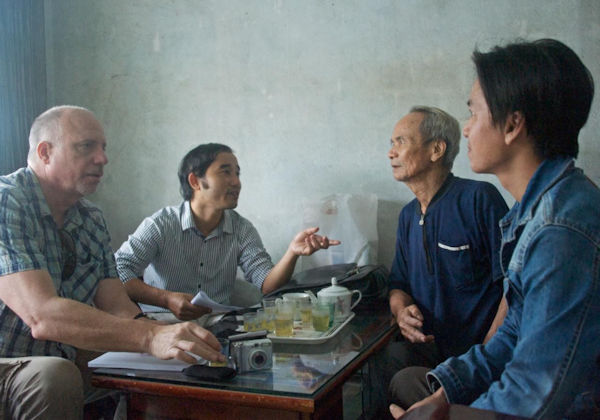SEJournal Online is the digital news magazine of the Society of Environmental Journalists. Learn more about SEJournal Online, including submission, subscription and advertising information.
 |
| Charles Schmidt, honored by SEJ for his reporting on lead poisoning in the United States, shown here (above left), during a reporting trip to Vietnam for a story on Agent Orange. Photo: Schmidtwriting.com. Click to enlarge. |
Inside Story: How a Lauded Reporter’s ‘Open Mind’ Led Story in a Surprising Direction
Lead exposure for children is a serious health problem, but treating too many lead-exposed children could actually overburden case management systems, ultimately causing more harm. That was the surprising finding of an investigation by Charles Schmidt for Undark that was recognized by the Society of Environmental Journalists’ 2019 Annual Awards for Reporting on the Environment, for honorable mention in the explanatory reporting category.
SEJ judges said of the counterintuitive "Lead Exposure” investigation, “This seemingly improbable claim, however, is corroborated by Schmidt's stellar reporting, which includes powerful testimony from physicians, officials and, most important, lead exposure sufferers themselves.”
SEJournal Online caught up with Schmidt to ask about the project. Here is the conversation.
SEJournal: How did you get your winning story idea?
Charles Schmidt: From one of my sources. I was doing some reporting for a different story on treatments for lead poisoning, and a professor at the University of Cincinnati became very animated when I asked him about a pending drop in the blood threshold that triggers interventions for children. He was dead set against it and that piqued my curiosity. So I started digging in and found that many experts felt the same way, though most hadn't shared those opinions publicly.
SEJournal: What was the biggest challenge in reporting the pieces and how did you solve that challenge?
Schmidt: Finding the parents of a lead-exposed child who would agree to be photographed and go on record. This took weeks of time and innumerable phone calls and emails. None of the lead advocacy groups were helpful. We found a single mother who would talk. I wrote a first draft of the story with her and her child in the lede. And then at the last moment she dropped out on account of a pending lawsuit against her landlord. That set us back another month at least. Finally, the photographer I was working with, Maddie McGarvey, came through with someone else who was perfect. Thank you Maddie!
SEJournal: What most surprised you about your reporting/findings?
Schmidt: The counter-intuitive conclusion that dropping the blood-lead threshold would only further harm the children who are most at risk from lead poisoning.
SEJournal: How did you decide to tell the story and why?
Schmidt: Kudos on this one to my editor, Tom Zeller at Undark, who assigned the story and played an invaluable role in pushing it forward. I pitched it to him, he responded enthusiastically, and then I got to work. Getting the story right took an enormous amount of reporting. When your conclusions run counter to accepted orthodoxy in the lead/public health community, the reporting has to be solid. I told the story as a (beautifully illustrated — thank you again Maddie!) long-form feature.
SEJournal: What would you do differently now, if anything, in reporting or telling the story and why?
Schmidt: I can't think of anything I would do differently. I found the story, met personally with sources, reported it, wrote it and pretty much keeled over when it was done.
SEJournal: What lessons have you learned from your project?
Great stories can fall in your lap when you let
your sources meander a bit beyond what
you had initially set out to cover with them.
Schmidt: It really affirmed how great stories can fall in your lap when you let your sources meander a bit beyond what you had initially set out to cover with them. If you relax and listen for a while, it's possible that the detour will lead you to something unexpected and new.
SEJournal: What practical advice would you give to other reporters pursuing similar projects, including any specific techniques or tools you used and could tell us more about?
Schmidt: There are always two sides to a story and you should learn them both. That's especially true when it comes to environmental reporting. Talk to lots of people on both sides of an issue and listen to what they say. Then craft your story based on the facts that you reported and not on the biases that you came into it with. Have an open mind. Don't be afraid to go out on a limb. Report, report, report. Do the work. Hopefully, someone is paying you enough. Adequate payment is hard to come by these days, so look for efficiencies where you can.
SEJournal: Is there anything else you would like to share about this story or environmental journalism?
Schmidt: I can't think of a time that we needed great environmental reporting more than we do now.
Charles Schmidt is a science writer based in southern Maine. Trained in public health, he’s covered health, medicine, the environment, technology and other topics for more than two decades for publications including Science, Nature Biotechnology, Scientific American, Discover Magazine and The Washington Post. Schmidt is a recipient of the National Association of Science Writers’ Science in Society Journalism Award for his coverage of electronic waste exports to China. And he’s also a member of the Joint Chiefs, a Portland, Maine rock and roll band.
* From the weekly news magazine SEJournal Online, Vol. 6, No. 14. Content from each new issue of SEJournal Online is available to the public via the SEJournal Online main page. Subscribe to the e-newsletter here. And see past issues of the SEJournal archived here.













 Advertisement
Advertisement 



